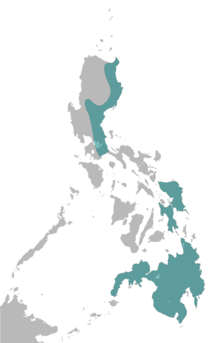
Back عقاب فلبينية Arabic عقاب فلبينى ARZ Kiiz (Pithecophaga) AVK Salimbagat BCL Орел маймунояд Bulgarian Àguila menjamones de les Filipines Catalan Tipuli CEB Orel opičí Czech Eryr y Philipinau Welsh Abeørn Danish
| Philippine eagle | |
|---|---|

| |
| Philippine eagle at the Philippine Eagle Center, Davao City | |
| Scientific classification | |
| Domain: | Eukaryota |
| Kingdom: | Animalia |
| Phylum: | Chordata |
| Class: | Aves |
| Order: | Accipitriformes |
| Family: | Accipitridae |
| Subfamily: | Circaetinae |
| Genus: | Pithecophaga Ogilvie-Grant, 1896 |
| Species: | P. jefferyi
|
| Binomial name | |
| Pithecophaga jefferyi Ogilvie-Grant, 1896
| |

| |
| Range in blue | |
The Philippine eagle (Pithecophaga jefferyi), also known as the monkey-eating eagle or great Philippine eagle, is a critically endangered species of eagle of the family Accipitridae which is endemic to forests in the Philippines. It has brown and white-colored plumage, a shaggy crest, and generally measures 86 to 102 cm (2.82 to 3.35 ft) in length and weighs 4.04 to 8.0 kg (8.9 to 17.6 lb).
The Philippine eagle is considered the largest of the extant eagles in the world in terms of length and wing surface area, with only Steller's sea eagle and the Harpy eagle being larger in terms of weight and bulk.[3][4] It has been declared the national bird of the Philippines.[5][6] The most significant threat to the species is loss of habitat, a result of high levels of deforestation throughout most of its range. Because of this, the IUCN Red List has classified the species as “critically endangered”.
Killing a Philippine eagle is a criminal offence, punishable by law with up to 12 years imprisonment and heavy fines.[7]
- ^ BirdLife International (2018). "Pithecophaga jefferyi". IUCN Red List of Threatened Species. 2018: e.T22696012A129595746. doi:10.2305/IUCN.UK.2017-3.RLTS.T22696012A129595746.en. Retrieved November 11, 2021.
- ^ "Appendices | CITES". cites.org. Retrieved January 14, 2022.
- ^ Tabaranza, Blas R. Jr. (January 17, 2005). "The largest eagle in the world". Haribon Foundation. Retrieved September 23, 2012.
- ^ Ferguson-Lees, J.; Christie, D. (2001). Raptors of the World. London: Christopher Helm. pp. 717–19. ISBN 0-7136-8026-1.
- ^ Kennedy, R. S., Gonzales, P. C.; Dickinson, E. C.; Miranda, H. C. Jr. and Fisher, T. H. (2000). A Guide to the Birds of the Philippines. Oxford University Press, New York. ISBN 0-19-854669-6
- ^ Pangilinan, Leon Jr. (October 3, 2014). "In Focus: 9 Facts You May Not Know About Philippine National Symbols". National Commission for Culture and the Arts. Archived from the original on November 26, 2016. Retrieved January 8, 2019.
- ^ "Farmer arrested for killing, eating rare Philippines eagle: officials". AFP. July 18, 2008. Retrieved March 28, 2019.
© MMXXIII Rich X Search. We shall prevail. All rights reserved. Rich X Search
